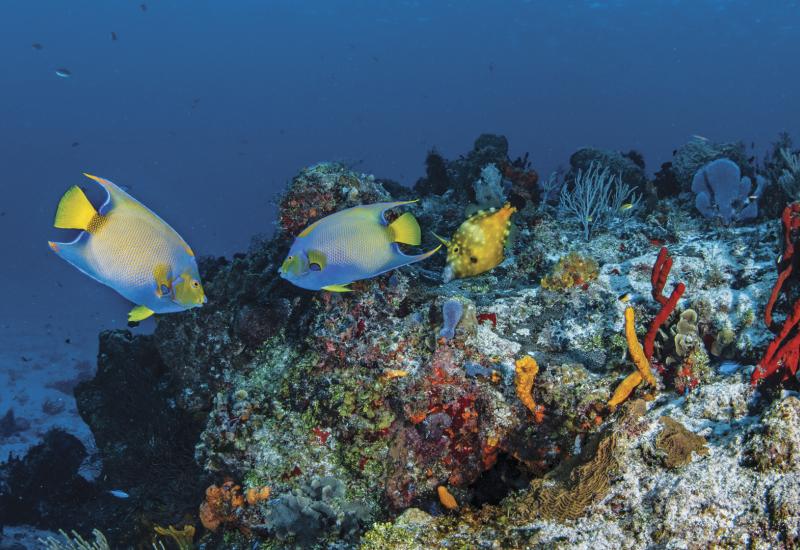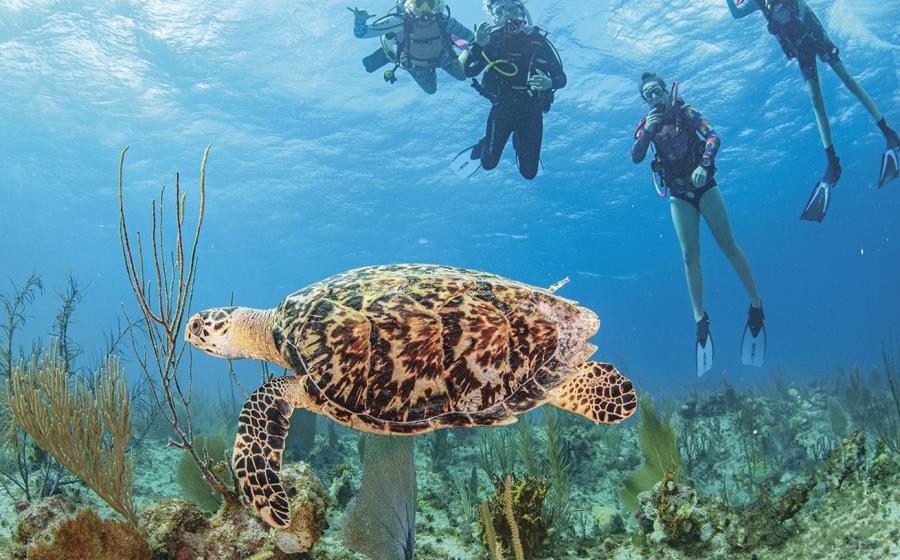Cozumel's Currents of Life
A refreshing tropical breeze and an impossibly blue sky dotted with cottony white clouds greeted me in Cozumel. After spending five hours cooped up in a plane, it was time to put the sunglasses on and find a place to get wet. My search was not very difficult or time-consuming. In addition to beautiful hotels and resorts, the western side of the island is loaded with prime snorkeling and dive sites. Since it was too late in the day to set up my dive gear, I grabbed a snorkel and trekked across the khaki-colored sand in front of my room at the Hotel Presidente toward the lapping Caribbean waters.I didn't really expect much. After spending years as a live-aboard dive-boat captain in Palau, Truk, Belize and the Cayman Islands, I imagined that these reefs would be pretty tame. I was in for an eye-opening surprise. Just offshore I found a patch reef community rivaling any I have explored in Belize or Little Cayman. Peacock flounders jockeyed for position on the white-sand bottom. Ringed anemones blossomed from beneath the reef, their tentacles whirling around a purple-and-white snapping shrimp. A nearby juvenile rock beauty went about the business of being shy but interested. All this to see on a single breath-hold dive! My preconceived notions of Cozumel blew away like smoke. If a 45-second free dive could reveal so much marine life, what would a 45-minute dive to one of the better sites along the southwest coast reveal?WATCHFUL EYES We headed out the next morning for Yocab Reef (pronounced u-cab). Upon arriving at the dive site, we saw a dozen or so other dive boats circling the area. How could this reef possibly survive so much diving pressure? Dropping into the gin-clear water, I immediately felt the tug of a north-flowing current Q not strong, but very persistent. As I settled toward the bottom 45 feet below, I could make out every detail of the low coral archway that was our destination. A school of French grunts and schoolmasters lingered in the shadows while a pair of gray angelfish abandoned their cleaning station to check us out. My dive buddy, Lene, is one of the instructors with Scuba Du, the hotel's dive shop. Circling behind the archway, she faced into the current to provide the ''human element'' for my photography. The ''marine life element'' for the picture posed no problem. Bright-orange elephant ear sponges, azure vase sponges, red encrusting sponges, mauve-colored hydrocorals and lavender deepwater gorgonians were artistically arranged along and under the archway in a way that complimented Lene's position and contrasted beautifully with the indigo-colored water. And then the crowd arrived. Fifteen divers piled into the water behind me as I tried to compose my picture. Distracted by a loud rapping on a tank, I looked up to see the group's divemaster gesturing emphatically at a diver who had passed too close to the coral. Like an underwater mother hen, the divemaster then collected his divers, organized their buoyancy and continued with the tour of the reef. Looking back toward Lene, it was clear that she hadn't seen anything new with these underwater gesticulations. Later she tells me that is standard operating procedure for Cozumel's dive guides. They are very serious about reef stewardship in the Marine Parque Nacional. Fishing in the park is a serious offense, and careless diving that endangers the reefs is taken no less lightly. We continued our underwater photography session, taking advantage of the good light and robust reef. A giant barrel sponge, pink on the inside and lavender on the outside, provided the foreground for our next picture. This massive sponge is perhaps 100 years old and still thriving. We also passed tall heads of star coral that offered attachment points for gorgonians and a myriad of sponges. KEYS TO A HEALTHY REEF Clearly these reefs are very healthy. Despite Hurricane Gilbert, despite El Ni-o and despite divers who come here by the thousands, the corals and associated marine life are thriving. Why? With a kick of my fins, I was again in the current moving along Yocab Reef. Suddenly I knew the answer to my question. It's here, sailing along with me in the current. For these perpetual currents of Cozumel constantly stir the lifeblood of its reefs. The flow delivers an endless stream of nutrients that enriches the ecosystem. The result is a vibrancy that overcomes diver pressure with a mere shrug, and that overcomes El Ni-o by simply mixing things up. Add to these currents the active stewardship of the island's divemasters and I am very happy to report that the reefs remain resplendent. With film and air nearly used up, we make our ascent to the surface. During the next five minutes we hang at 15 feet, all the while riding that life-giving current that nourishes the reefs below. The next question that crosses my mind is will our boat captain be able to find us when we finally surface? We have covered nearly a mile during our underwater ramblings. Breaking the surface, we see that our boat is already heading toward us. These guys are pros. TOPSIDE DIVERSITY Later, during happy hour at a local watering hole, I was again overwhelmed by the onslaught of color and diversity. The currents bring health and vibrancy to the reefs, and that in turn attracts the tourists. Like me, some fly in, while others come ashore from the gleaming white cruise ships. Some are well-tanned and many are well-burned. Some like frozen margaritas and some like cerveza with a lime. Around 6 p.m., the island's whole atmosphere gets very warm as the big orange ball moves majestically toward the horizon. Conversations are lively and good-natured, and content is unimportant. When the sun sets, everything becomes beautiful and we all become a little younger and a bit friendlier. Clyde from Phoenix laughs easily, Robert from Miami endears himself to otherwise perfect strangers, and Richard and Betsy from Cincinnati hold on to each other very tightly, hoping to make this moment last forever. And then the mariachi band begins to play. At 5:30 a.m. the next day, I sit in the lounge chair outside my room gazing at the Caribbean and sipping the coffee that was delivered with my wake-up call. The coral marl of the deck is cool under my bare feet. Looking west toward the Yucatan, lights twinkle on the horizon from the mainland village of Playa del Carmen. The moon is setting as the sky begins to lighten in the east. Crickets serenade the predawn. With the first bird song, the crickets become quiet. More birds start to sing and a not-too-distant rooster crows whiles waves wash onto the beach. It's time to get the cameras and the dive gear ready for another adventure.SEARCHING FOR SEAHORSES Today I am in search of some rare and unusual marine life to photograph. To me, these are important indicators of a reef's biodiversity. At the dive shop, I ask a dive instructor named Luis if it is possible to find seahorses in the waters near Cozumel. His response is deadpan. ''What color seahorses would you like? We have red or yellow.'' It turns out that seahorses are frequently seen just 150 feet offshore from the hotel. This tip is too good to pass up. ''Please tell the dive boat that I will be doing shore dives today,'' I reply. Lumbering toward the dock, I struggle in the earlymorning heat with the weight of my scuba gear and housed camera. Suddenly there is Lene at my heels. Speaking in a curious mix of Dutch and Spanish, she asks me: ''Would you like me to show you where the seahorse lives?''''That would be great,'' I managed to say. For more information about diving Cozumel's wonders, click on the home page below. For information about where to stay on Cozumel, click on the home page below.










